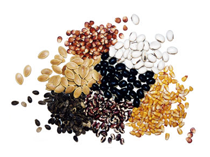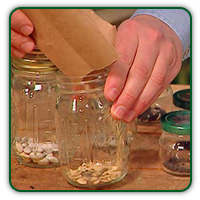 Seed Saving Information Seed Saving Information
In gardening, seed saving is the practice of saving seeds or other reproductive material from open-pollinated vegetables, grain, herbs, and flowers for use from year to year for annuals and nuts, tree fruits, and berries for perennials and trees. This is the traditional way farms and gardens were maintained. In recent decades, there has been a major shift to purchasing seed annually from commercial seed suppliers, and to hybridized or cloned plants that do not produce seed that remains "true to type"-retaining the parent's characteristics- from seed. Much of the grassroots seed-saving activity today is the work of home gardeners. However, it is gaining popularity among organic farmers, permaculturists and enthusiasts with cultural or environmentalist interests.
Open pollination, or Non-Hybrid, is the key to seed saving. Plants that reproduce through natural means tend to adapt to local conditions over time, and evolve as reliable performers, particularly in their localities, known as landraces or "folk varieties". The modern trend to rely on hybridized and cloned plants negates these evolutionary processes. Hybrid plants are artificially cross-pollinated, and bred to favor desirable characteristics, like higher yield and more uniform size to accommodate mechanized harvesting. However, the seed produced by the second generation (F2) of the hybrid does not reliably produce a true copy of that hybrid and often loses much of its yield potential. Likewise the cloned cultivars of many perennials such as seedless grapes have lost the ability to even reproduce by seeds.
While comprehensive figures are hard to come by, one popular view today holds that thousands of varieties of vegetables and flowers are being lost, due to reliance on commercial hybrid seed. Widespread use of a relatively few mass-marketed hybrid seed varieties, in both home gardening and commercial farming, is said to be eliminating many open-pollinated varieties, especially the local variations that were naturally developed, when local seed-saving was the common practice. The concern is that this erodes the gene pool, resulting at some point in less hardy, more vulnerable plants. Countering this trend, and an affinity for variety and tradition, are the principal motivations for many large seed-saving groups.
Tips on Saving Seeds
Seed saving is not always feasible with all types of vegetables, but collecting your own seed can be an exercise in self-sufficiency and a lesson in plant biology. Seeds you save from your home production system are accustomed to your climate and growing medium and are adapted to pests in your area. Seeds are generally saved from annual and biennial plants. Perennials are usually propagated through division or cuttings.
The easiest seeds to save are open-pollinating, non-hybrid annuals. Plants that are not self-pollinating can cross-pollinate; therefore, it is best to grow only one variety of a plant from which you want to save seed that season. If two varieties of spinach bloom near each other, the resultant seed is likely to be a cross between the two. Different varieties of peppers should be separated by 500 feet to avoid cross-pollination. Melons, pumpkins, cucumbers, and squash need even more personal space--at least a half-mile is required.
Biennials require more work and commitment. These plants do not send up seed stalks until the second season. Biennials include beets, Brussels sprouts, cabbage, carrots, cauliflower, celery, onions, parsley, parsnips, rutabaga, salsify, Swiss chard, and turnips.
Do not save seed from hybrid varieties if you want plants like the parents. Seeds from hybrid varieties produce a mix of offspring, many of which may have different characteristics than the parent. Seed from hybrid vine crops is often quite variable also - squashes, cucumbers, melons and pumpkins often cross-pollinate with other genetically compatible varieties. Unless pollination has been strictly controlled, strange hybrids often result in the next generation.
Among the vegetable seeds most easily saved are non-hybrid tomato, pepper, bean, eggplant, cucumbers, summer squash, and watermelons. Collect seeds from the fully mature, ripe fruit of these plants.
 Tomatoes: The seeds are encased in a gelatinous coating, which prevents them from sprouting inside the tomato. Remove this coating by fermenting it. This mimics the natural rotting of the fruit and has the added bonus of killing seed borne tomato disease. Squeeze the seeds from a fully ripe fruit into a bowl, add water and let stand at room temperature for about three days. Once fermentation occurs, mold will form on the surface of the water. Add more water, stir, then gently scrape mold and debris off the top. Repeat until only clean seed remains, strain, rinse, and leave the seeds at room temperature until they are thoroughly dry. Tomatoes: The seeds are encased in a gelatinous coating, which prevents them from sprouting inside the tomato. Remove this coating by fermenting it. This mimics the natural rotting of the fruit and has the added bonus of killing seed borne tomato disease. Squeeze the seeds from a fully ripe fruit into a bowl, add water and let stand at room temperature for about three days. Once fermentation occurs, mold will form on the surface of the water. Add more water, stir, then gently scrape mold and debris off the top. Repeat until only clean seed remains, strain, rinse, and leave the seeds at room temperature until they are thoroughly dry.
 Peppers: Select a mature pepper, preferably one that is completely red. Cut the pepper open, scrape the seeds onto a plate and let the seeds dry in a non-humid, shaded place, testing them occasionally until they break rather than bend. Leave at room temperature until completely dry. Peppers: Select a mature pepper, preferably one that is completely red. Cut the pepper open, scrape the seeds onto a plate and let the seeds dry in a non-humid, shaded place, testing them occasionally until they break rather than bend. Leave at room temperature until completely dry.
 Beans, peas, and other legumes: Leave pods on the plant until they are "rattle dry." Pick the pods and remove the seeds when completely dry. Beans, peas, and other legumes: Leave pods on the plant until they are "rattle dry." Pick the pods and remove the seeds when completely dry.
 Eggplant: Leave the plant on the vine until it is well past the stage when you would pick it for kitchen purposes. Eggplants ready for seed saving will be dull, off-colored and hard. Cut the eggplant in half and pull the flesh away from the seeded area. Eggplant: Leave the plant on the vine until it is well past the stage when you would pick it for kitchen purposes. Eggplants ready for seed saving will be dull, off-colored and hard. Cut the eggplant in half and pull the flesh away from the seeded area.
 Cucumbers: Cucumbers change color after they ripen and start to become mushy. Cut it in half and scrape the seeds into a bowl. Remove their slimy coating by rubbing them gently around the inside of a sieve while washing them or soak them in water for two days. Rinse and dry. Cucumbers: Cucumbers change color after they ripen and start to become mushy. Cut it in half and scrape the seeds into a bowl. Remove their slimy coating by rubbing them gently around the inside of a sieve while washing them or soak them in water for two days. Rinse and dry.
 Summer squash: Summer squash is at the seed-saving stage when you cannot dent the squash with a fingernail. Cut it open, and scrape the seeds into a bowl, wash, drain, and dry. Summer squash: Summer squash is at the seed-saving stage when you cannot dent the squash with a fingernail. Cut it open, and scrape the seeds into a bowl, wash, drain, and dry.
 Watermelon: Put the seeds from ripe fruit in a strainer and add a drop of dishwashing liquid to remove any sugar from the seeds. Watermelon: Put the seeds from ripe fruit in a strainer and add a drop of dishwashing liquid to remove any sugar from the seeds.
Tips on Storing Seeds
 Storing seeds: Store most seed packets in airtight jars. The exception is legumes, which store best in breathable bags. To keep the seeds dry, fill a small cloth bag with about one-half cup dried powdered milk. Place the packet in the jar beneath the seed packets. Be sure to label your container with the variety, the date, and other pertinent information. Store your seeds in a cool, dark, dry place; a refrigerator is a good choice. Avoid opening the container until you are ready to plant. Storing seeds: Store most seed packets in airtight jars. The exception is legumes, which store best in breathable bags. To keep the seeds dry, fill a small cloth bag with about one-half cup dried powdered milk. Place the packet in the jar beneath the seed packets. Be sure to label your container with the variety, the date, and other pertinent information. Store your seeds in a cool, dark, dry place; a refrigerator is a good choice. Avoid opening the container until you are ready to plant.
Stored seeds will retain their viability for different lengths of time depending on the type of seed. Melon seed can be stored for as long as five years, while sweet corn is only good for one year. Other types of seed remain viable for two to three years.
|